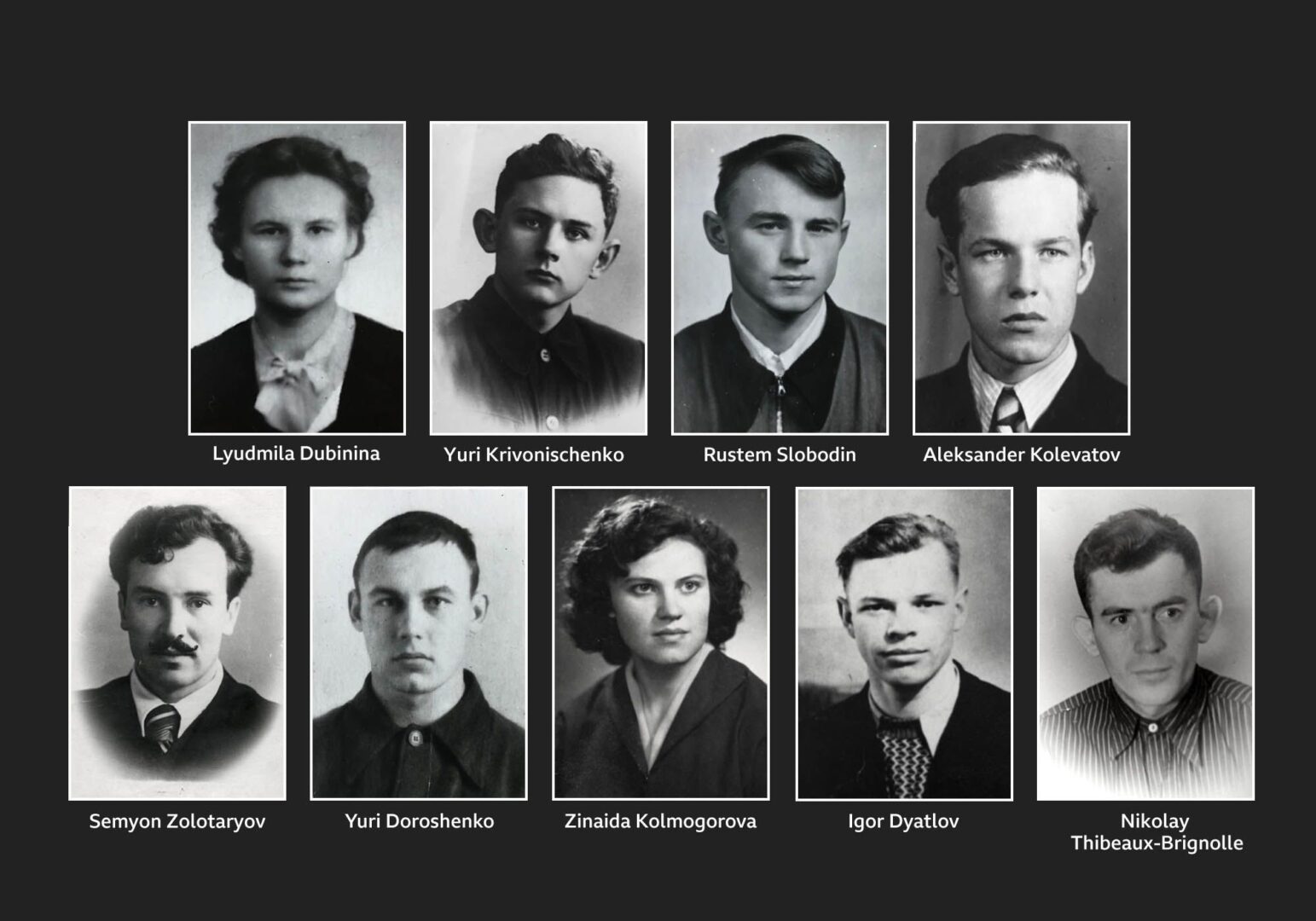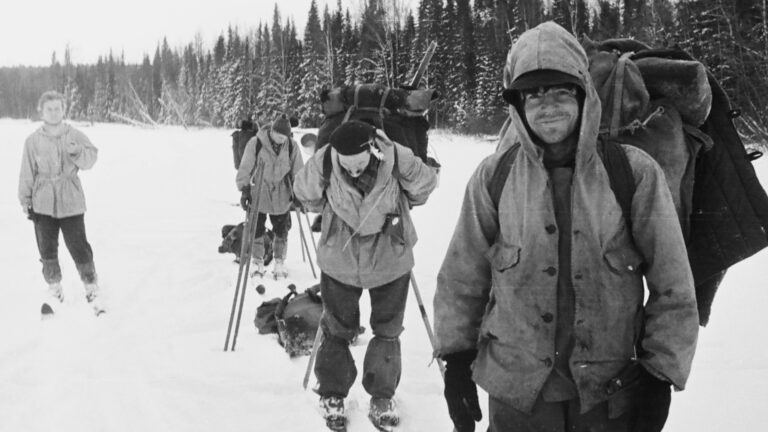In the heart of Russia’s Ural Mountains lies a chilling enigma that has gripped the collective imagination, leaving investigators, adventurers, and conspiracy theorists spellbound for over sixty years—the Dyatlov Pass Incident. It is a haunting tale that unfolds against a backdrop of remote wilderness, and it involves nine young hikers who embarked on a seemingly routine expedition in February 1959, only to meet a fate that defies comprehension. As we embark on this journey into the shadows of the Ural wilderness, we find ourselves drawn into a narrative marked by mystery, intrigue, and inexplicable tragedy.
The Dyatlov Pass Incident begins with a group of ten hikers, all students from the Ural Polytechnic Institute, driven by a shared passion for exploration and adventure. Under the leadership of Igor Dyatlov, a seasoned hiker with a penchant for the unknown, they set out on an ambitious trek into the Ural Mountains, with the goal of reaching Otorten, a mountain nestled in the northern Urals. Armed with essential supplies, winter gear, and youthful enthusiasm, their journey was initially filled with excitement and camaraderie.
On a frigid January day in 1959, the group departed from the city of Sverdlovsk (now Yekaterinburg), boarding a train bound for the remote village of Vizhai, near the starting point of their expedition. However, their journey was fraught with delays and challenges that foreshadowed the unsettling events to come.
Upon their arrival in Vizhai on January 28, the group spent several days preparing for their trek. They procured provisions, familiarized themselves with the local inhabitants, and finalized their plans for the adventure ahead. The camaraderie among the hikers was evident, their shared passion for exploration forging bonds that would soon be tested in the harshest of ways.
On January 31, 1959, the group set forth from Vizhai, venturing deeper into the Ural Mountains with a sense of purpose and anticipation. As they ascended into the highlands and into the heart of the wilderness, little did they know that their journey would take them into the annals of one of the most perplexing and chilling mysteries of the modern era.
As we embark on this exploration of the Dyatlov Pass Incident, we step into a world where the boundaries between fact and conjecture blur, where the wilderness conceals secrets, and where the events of a fateful night in February 1959 continue to cast a long and enigmatic shadow. This journey will take us deep into the heart of Dead Mountain, into a narrative marked by the inexplicable, the eerie, and the enduring quest for answers to the riddle that has confounded the world for generations.
The Begining of the Mysterious Case of the Dyatlov Pass Incident

In January 1959, a group of ten hikers, all students from the Ural Polytechnic Institute, set out on an ambitious trek into the Ural Mountains. Led by Igor Dyatlov, an experienced hiker, the group aimed to reach Otorten, a mountain located in the northern Urals. The expedition was meant to be a challenging but exciting adventure, and the team was well-prepared, carrying essential supplies, winter gear, and a shared spirit of camaraderie.
On January 27, 1959, the group boarded a train from Sverdlovsk (now Yekaterinburg), bound for Vizhai, a small village near their intended starting point. After a series of delays, they finally arrived in Vizhai on January 28. Here, the group spent a few days preparing for the trek, acquiring the necessary provisions, and acquainting themselves with the local inhabitants.
The Fatal Decision
On January 31, the group departed from Vizhai, heading towards the base of the mountains. By February 1, they reached the edge of the highlands and began their ascent into the Ural wilderness. On this day, one member, Yuri Yudin, who had been experiencing health issues, made the difficult decision to turn back. Little did he know that his choice to leave the expedition would be a fateful one.
The remaining nine members—Dyatlov, Zinaida Kolmogorova, Yuri Doroshenko, Lyudmila Dubinina, Alexander Kolevatov, Rustem Slobodin, Georgiy Krivonischenko, Nicolai Thibeaux-Brignolle, and Semyon Zolotaryov—pressed on, forging a path into the unforgiving wilderness.
The Discovery of the Abandoned Camp
In the following days, the group made steady progress into the mountains, as recorded in their diaries and camera film. On February 1, they reached a wooded area known as the cedar forest, where they spent the night. By February 2, they had reached the edge of the treeline, and it was here that they made their fateful decision to establish a campsite on the slopes of Kholat Syakhl, or “Dead Mountain” in the local Mansi language.
The choice of this location has been a subject of speculation, as it offered little shelter from the elements and was farther from their intended route. Nevertheless, the group proceeded to set up camp on the slopes of Kholat Syakhl. They pitched their tent, cooked a meal, and prepared for what should have been another night of rest before continuing their ascent. However, this would be the last time anyone would see them alive.
The Baffling Disappearance
In the weeks that followed, concern grew among the hikers’ families and friends when they failed to return from their expedition. On February 20, a search party was organized to locate the missing group. What they would discover in the days ahead would send shockwaves through the region and beyond.
On February 26, the searchers found the abandoned campsite of the Dyatlov group. The tent, ripped open from the inside, stood eerily empty. The hikers’ belongings, including their winter gear and footwear, were left behind. This perplexing scene indicated that they had fled their campsite in a hurry, amid extreme cold and heavy snowfall.
Following the tracks left in the snow, searchers eventually located the remains of the first two hikers, Yuri Doroshenko and Yuri Krivonischenko, some 1,500 meters from the campsite. They were dressed only in their underwear, and their bodies bore signs of severe frostbite and injuries consistent with a violent struggle.
The Gruesome Discoveries
The mystery deepened as the search party continued to uncover more grim findings. Three more bodies, those of Dyatlov, Kolmogorova, and Slobodin, were discovered between the camp and the forest as if they had been attempting to return to the tent. Like Doroshenko and Krivonischenko, they were underdressed for the brutal conditions, with signs of frostbite and injuries.
It wasn’t until May that the snow began to recede, revealing more of the grim tableau. The remaining hikers’ bodies were found deeper into the forest, buried under several meters of snow. Their injuries were even more disturbing—Dubinina, Kolevatov, and Thibeaux-Brignolle had suffered massive internal trauma, akin to the effects of a high-speed car crash, despite no visible external injuries.
Adding to the macabre nature of the discovery, Dubinina and Zolotaryov were found without their eyes, and Zolotaryov was also missing his tongue. The tent’s exit, cut from the inside, suggested that the group had fled in sheer panic, barefoot and barely clothed, into the frigid wilderness.
Theories and Speculation about the Mystery
The Dyatlov Pass Incident has been a source of fascination and speculation for decades, with a multitude of theories proposed to explain the bizarre and gruesome events.
One of the earliest and most widely accepted theories suggests that the hikers may have been victims of a sudden avalanche. The theory posits that an avalanche, triggered by various factors such as wind and snow conditions, could have swept down the slope, burying the tent and causing the hikers to flee in a state of panic. However, this theory has faced criticism due to the lack of physical evidence of an avalanche, such as disturbed snow patterns.
Another theory proposes that infrasound, low-frequency sound waves undetectable by the human ear, may have played a role in the group’s panic and irrational behavior. Infrasound can be generated by natural phenomena, such as wind or avalanches, and it has been known to induce feelings of unease and fear in humans. While intriguing, this theory lacks conclusive evidence.
Conspiracy theories have also emerged, suggesting that the Soviet military may have been involved in the incident. Some theorists speculate that the hikers accidentally stumbled upon a secret military operation or weapons testing site, prompting the military to eliminate them. However, there is no concrete evidence to support this theory, and it remains in the realm of speculation.
Another plausible explanation for the hikers’ bizarre behavior and injuries is hypothermia, a condition that occurs when the body loses heat faster than it can produce it. Hypothermia can impair judgment, induce confusion, and lead to paradoxical undressing, where individuals in the late stages of hypothermia may inexplicably remove their clothing due to the sensation of overheating. While this theory explains some aspects of the incident, it does not account for all the injuries sustained by the hikers.
The Ongoing Investigation
Despite the passage of over six decades, the Dyatlov Pass Incident remains an open case, shrouded in mystery and unanswered questions. In recent years, efforts to uncover the truth behind the tragedy have seen renewed interest and investigation.
In 2018, Russian authorities announced that they would conduct new forensic examinations of the hikers’ remains in an attempt to shed light on the circumstances of their deaths—the decision to exhume the bodies and reexamine the evidence raised hopes of finally solving the mystery.
In addition to reexamining the physical evidence, investigators have also sought to reconstruct the events leading up to the incident. Using modern technology, simulations, and historical records, researchers have attempted to piece together a more comprehensive timeline of the hikers’ journey and their actions in the days preceding their deaths.
The digital age has allowed for the preservation and sharing of historical documents related to the Dyatlov Pass Incident. Researchers and enthusiasts have compiled extensive archives of photographs, diaries, and documents, enabling a more thorough examination of the group’s preparations and experiences.
The Legacy of the Dyatlov Pass Incident
The Dyatlov Pass Incident has left an enduring legacy that extends beyond the realm of mystery and conspiracy. It has captured the imagination of writers, filmmakers, and enthusiasts, inspiring numerous books, documentaries, and fictionalized accounts. The chilling story of the hikers’ tragic journey continues to captivate audiences and serves as a reminder of the enigmatic aspects of our world.
The Dyatlov Pass Incident has become a cultural phenomenon, with its share of legends, urban myths, and conjecture. It has inspired a wide range of artistic works, from novels and movies to music and video games. The enduring allure of the incident lies in its ability to evoke a sense of unease and curiosity.
The remote location of the Dyatlov Pass has not deterred curious adventurers from visiting the site of the incident. While the harsh climate and challenging terrain present formidable obstacles, some intrepid travelers seek to retrace the hikers’ footsteps and explore the area for themselves.
For the families of the hikers and those who have dedicated their efforts to unraveling the mystery, the quest for answers and closure remains a deeply personal and persistent endeavor. The passage of time has not diminished the determination to uncover the truth behind the Dyatlov Pass Incident.
Final Thoughts on the Dyatlov Pass Incident
The Dyatlov Pass Incident, a tale steeped in mystery, intrigue, and eerie circumstances, defies easy explanation. For over six decades, it has held its grip on the collective imagination, captivating the world with its enigmatic story of nine intrepid hikers who ventured into the heart of the Ural Mountains, only to meet a gruesome and unexplained fate. As we conclude our exploration of this chilling saga, we must acknowledge that, to this day, the Dyatlov Pass Incident remains an enduring enigma, casting a shadow over the Ural wilderness and the realm of unsolved mysteries.
The events of that ill-fated expedition continue to perplex and bewilder. The initial discovery of the abandoned campsite, marked by a shredded tent and the inexplicable absence of essential gear, was merely the beginning of a series of grim revelations. The subsequent findings of the hikers’ bodies, with their underdressed and frostbitten forms, raised more questions than answers. The gruesome injuries sustained by some of the hikers—internal trauma, missing eyes, and tongues—added layers of horror to an already perplexing tale.
Over the years, a multitude of theories and conjectures have emerged, seeking to shed light on the Dyatlov Pass Incident. The avalanche theory, infrasound, military involvement, and hypothermia-induced behavior have all been proposed as potential explanations. Yet, each theory falls short of fully accounting for the complex sequence of events and the peculiar injuries sustained by the hikers.
Despite the passage of time, the mystery has refused to yield its secrets. Recent efforts to reexamine the physical evidence, conduct new autopsies, and reconstruct the timeline of events have brought renewed hope of solving the puzzle. Yet, the answers remain elusive, veiled by the veil of time and the harsh Ural wilderness.
The legacy of the Dyatlov Pass Incident extends beyond the boundaries of a mere unsolved mystery. It has permeated our culture, inspiring countless books, documentaries, and artistic creations. The enduring allure of this chilling story lies in its ability to evoke a sense of unease and curiosity, inviting us to delve deeper into the unknown.
For the families of the hikers and the dedicated researchers who have devoted their lives to unraveling the mystery, the quest for answers continues. The passage of time has not diminished their determination to uncover the truth behind the Dyatlov Pass Incident. Their tireless efforts remind us that, in the face of the unknown, the human spirit persists in its pursuit of understanding and closure.
As we reflect on the enduring enigma of the Dyatlov Pass Incident, we are reminded of the mysteries that continue to shape our world. It stands as a testament to the boundless complexities of our natural environment, the limits of human knowledge, and the enduring capacity of the human spirit to seek answers in the face of the inexplicable.
The story of the Dyatlov Pass Incident is a haunting reminder that, within the depths of our world, there remain uncharted territories, both physical and metaphorical, waiting to be explored and understood. It is a story that challenges our intellect, piques our curiosity, and beckons us to venture into the unknown, in the hopes that one day, the veil shrouding the secrets of Dead Mountain may finally be lifted, and the truth may be revealed. Until that day comes, the Dyatlov Pass Incident will continue to cast its enigmatic shadow, an enduring testament to the enduring mysteries that persist in our complex world.

